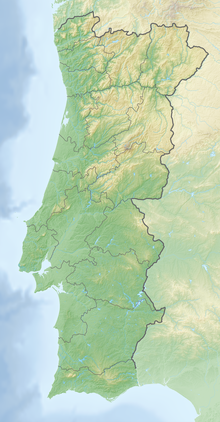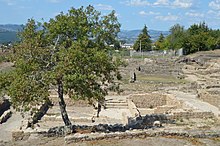Tongobriga
Location of Tongobriga in Portugal. |
Tongobriga is the name of a Roman city in northern Portugal , which goes back to a pre-Roman settlement with unbroken settlement continuity.
location
The settlement, the maximum extent of which is estimated to be around 7 hectares, is located around and partly below the town of Freixo in the municipality of Marco de Canaveses in northern Portugal.
The settlement area extends over an almost north-south oriented ridge in the landscape shaped by the Tâmega and Douro rivers .
history
Based on a Roman inscription found in the place as early as 1882 and the mention of Τουντό-βριγα near Ptolemy between Douro and Minho , the identification of the settlement with Tongobriga is largely accepted today.
research
The first excavations began in 1980 under the direction of Lino Augusto Tavares Dias and are continuously continued by the "Escola Profissional de Arqueologia" founded on site in 1990. Currently (2017) two excavation areas are open to the public. The northern area in the center, which is connected to the Centro interpretativo "Vida Quotidiana", which opened in 2010, as well as the thermal baths and forum area further south .
Since 1986 the site with a size of approx. 50 hectares has been registered and protected as a Monumento Nacional.
archeology
So far, the archaeological finds allow the foundation of the Roman city to be dated to the Augustan period. At the end of the 1st and 2nd centuries AD there was a significant expansion of the settlement area and the establishment of a forum , thermal baths and temples illustrates the greatly increased economic importance of Tongobriga during this period. To the south of the city wall excavated fire graves of the 3rd and 4th centuries. 4th century, the remains of an early Christian basilica under today's church as well as the mention of Tongobriga as a Suebian parish prove a continuous settlement up to the 6th century.
Residential area
The northern settlement area in the center of today's town is only accessible to visitors via the attached museum, which presents a very manageable number of finds.
On the plateau, which has largely been eroded, there are individual round and rectangular houses in the local, pre-Roman tradition, as evidenced in large numbers from the Castro culture .
Immediately adjacent are Roman villae urbanae , some with an atrium, which are oriented towards a right-angled street system. The spatial proximity of indigenous pre-Roman structures and Roman villae illuminates in a unique way the progressive Romanization of the settlement in the 1st and 2nd centuries AD. Opposite the museum, remains of an early Christian basilica (5th and 6th centuries) as well as a mosaic floor exposed (not publicly accessible).
If you follow the main road down the slope to the south, another area with round houses extends east on the slope, shortly before reaching the southern city wall, and parts of the reconstructed city wall south of it.
Cremation graves from the 3rd and 4th centuries were excavated directly outside the city wall, also on the eastern slope.
Also south outside the city wall, west of the burial ground, the forum, the Pedra Formosa and the Roman thermal baths extend on a smaller plateau.
Forum
The long rectangular forum with a size of 112 x 75 m was built at the intersection of various Roman roads, the most important of which was probably that from Bracara Augusta ( Braga ) to Emerita Augusta ( Mérida ) in Spain.
Thermal baths
Immediately to the north-west of the forum, the thermal baths were built, the rising masonry of which is still partially preserved up to a height of 5 m. In addition to the praefurnium , the cold and hot water areas have also been preserved. The forum was used from the 1st century AD to the 5th century AD.
Pedra Formosa
The Pedra Formosa connects to the west of the thermal baths ; a small two-room system with an anteroom, the entrance to which is closed from the anteroom with a stone slab. Access to the interior is only possible through a small opening in the plate. Similar systems were found in the fortified pre-Roman settlements of Briteiros and Sanfins . However, the Tongobriga facility is completely carved out of the rock.
The interpretation of this pre-Roman complex is still controversial and ranges from a profane use as a (steam) bath to a sacred complex.
literature
- Thomas G. Schattner (ed.): Archaeological guide through Portugal (= cultural history of the ancient world . Volume 74). Philipp von Zabern, Mainz 1998, ISBN 3-8053-2313-1 , p. 86.
- Lino Augusto Tavares Dias, Tongobríga, Os caminhos romanos que ali chegavam. In Arqueologia Porto. Volume 19, 1989.
- Further reading under: Patrimonio Cultural in the Bibliografia section
Web links
Individual evidence
- ↑ Adolf Schulten: Τουντό-βριγα . In: Paulys Realencyclopadie der classischen Antiquity Science (RE). Volume VII A, 2, Stuttgart 1948, Sp. 1361.
- ↑ a b c d e f g Thomas G. Schattner (ed.): Archaeological guide through Portugal (= cultural history of the ancient world. Vol. 74). Philipp von Zabern, Mainz 1998, p. 85.
- ↑ Tongobriga_sitio. Retrieved September 22, 2017 .
- ^ Portal do Arqueólogo. Retrieved September 17, 2017 .
- ↑ Tongobriga_escola. Retrieved September 17, 2017 .
- ↑ Tongobriga_centro. Retrieved September 17, 2017 .
- ^ Portal do Arqueólogo. Retrieved September 17, 2017 .
- ↑ a b Tongobriga_necropole. Retrieved September 22, 2017 .
- ↑ Tongobriga_basilica. Retrieved September 19, 2017 .
- ↑ Tongobriga_habitacional. Retrieved September 22, 2017 .
- ↑ Tongobriga_forum. Retrieved September 22, 2017 .
- ↑ Tongobriga_termas. Retrieved September 22, 2017 .
Coordinates: 41 ° 9 ′ 53 " N , 8 ° 8 ′ 49" W.


